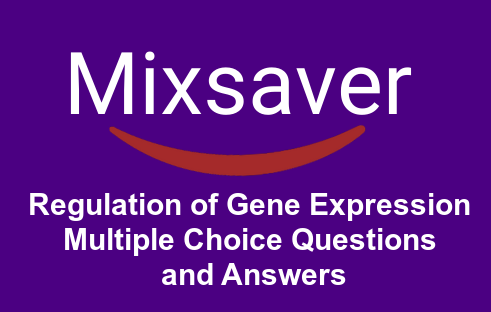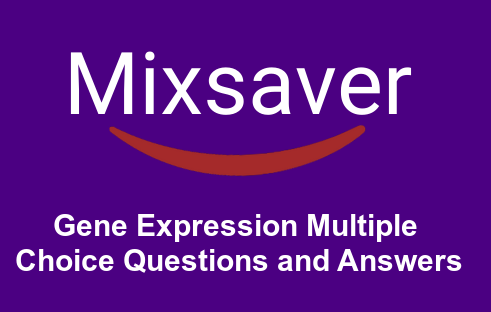Gene Expression Questions and Answers pdf
1. Expression of gene is controlled in eukaryotes
(a) at one place in the nucleus
(b) at many places in the nucleus
(c) at many places in the cell
(d) cannot be controiled at all
Ans. c
2. The example of inducible operon is
(a) trp operon
(b) lac operon
(c) Both (a) and (b)
(d) None of these
Ans. b
3. In trp operon, the co-repressor is
(a) tryptophan
(b) lactose
(c) Beta-galactoside
(d) glucose
Ans. a
4. Which one of the following is not a component of lac operon model?
(a) Promoter gene
(b) Structural gene
(c) Primer gene
(d) Regulator gene
Ans. c
5. The sequence of structural gene in lac operon
(a) lac A, lac Y, lac Z
(b) lac A, lac Z, lac Y
(c) lac Y, lac Z, lac A
(d) lac Z, lac Y, lac A
Ans. d
6. Operon system consists of
(a) operator and structural genes
(b) operator, regulator, repressor
(c) promoter and all of the above
(d) None of the above
Ans. a
7. Which molecule is not produced by E. coli in the lactose medium?
(a) Lactose dehydrogenase
(b) Thiogalactoside transacetylase
(c) Beta-galactosidase
(d) Lactose permease
Ans. a
8. The lactose operon consists of
(a) four genes-one inhibitor, one operator and two structural genes
(b) five genes-one inhibitor, one operator and three structural genes
(c) six genes-one inhibitor, one operator and four structural genes
(d) three genes-one inhibitor, one operator and structural genes
Ans. b
9. Aporepressor is inactive repressor in tryptophan repressible operon system. It is generally a
(a) protein
(b) substrate
(c) metabolite
(d) None of these
Ans. a
10. The regulatory genes are located
(a) in between operator and the structural genes
(b) in the middle of the structural genes
(c) at the end of the structural genes
(d) in front of the structural genes
Ans. d
Regulation of Gene Expression Quiz
11. Addition of lactose in a culture of E. coli induces enzymes to breakdown the lactose into glucose and galactose.
(a) B-galactosidase and transacetylase
(b) transacetylase and permease:
(c) B-galactosidase, permease, transacetylase
(d) None of the above
Ans. c
12. In lac operon system, lac gene-z codes for
(a) permease
(b) repressor
(c) transacetylase
(d) Beta-galactosidase
Ans. d
13. Which one of the following statements regarding lac operon is correct?
(a) Lac operon is inducible system
(b) Lac operon is repressible system
(c) Lac operon of E. coli contain four structural genes
(d) None of the above
Ans. a
14. In both inducible and repressible systems, the synthesis of protein is controlled by
(a) operator gene through regulator gene
(b) regulator gene through operator gene
(c) promoter gene through regulator gene
(d) operator gene through regulator and promoter genes
Ans. a
15. In eukaryotes, the regulation could be exerted at
(a) transcriptional and processing level
(b) processing and translational level
(c) transport of MRNA from nucleus to the cytoplasm
(d) All of the above
Ans. d
16. Who were the first to elucidate a transcriptionally regulated system?
(a) Francois Jacob and Jacque Monod
(b) Alfred Hershey and Martha Chase
(c) Oswald Avery and MacLeod
(d) Sever Ochoa and Nirenberg
Ans. a
17. Regulation of lac operon by repressor is referred as
(a) positive regulation
(b) negative regulation
(c) feed back regulation
(d) None of these
Ans. b
18. Which of the following statements is correct?
(a) Glucose acts as inducer for lac operon
(b) Galactose acts as inducer for lac operon
(c) Glucose or galactose act as inducers for lac operon
(d) Glucose or galactose cannot act as inducers for lac operon
Ans. d
19. Lactose is the substrate for the enzyme ß-galactosidase, it regulates
(a) switching on of the operon
(b) switching off of the operon
(c) Both (a) and (b)
(d) synthesis of polypeptide chain
Ans. a
20. The operator gene of lac operon is ‘turned on’ when lactose molecules bind to
(a) operator gene
(b) repressor protein
(c) mRNA
(d) promoter site
Ans. b
Gene Expression Practice Questions
21. When tryptophan is present in the medium, the transcription of tryptophan producing genes in E. coli is stopped by a helix-turn-helix regulator binding to the
(a) trp repressor
(b) trp operator
(c) trp operon
(d) trp promoter
Ans. d
22. In order for a gene to be transcribed, RNA polymerase must have access to the DNA helix and be able to bind to the genes
(a) operator
(b) promoter
(c) activator
(d) regulator
Ans. b
23. In the function of the lac operon in E. coli, the lac genes are transcribed in the presence of lactose because
(a) the repressor cannot bind to the operator
(b) RNA polymerase binds to the operator
(c) an isomer of lactose binds to operator
(d) CAP does not binds t the operator
Ans. c
24. The most common form of gene expression regulation in both bacteria and eukaryotes is
(a) translational control
(b) transcriptional control
(c) post-transcriptonal control
(d) post-translational control
Ans. b
25. E. coli is able to use foods other than glucose in the absence of available glucose, because falling levels of glucose cause an increase of
(a) CAMP
(b) CAP
(c) glu operon
(d) lactose
Ans. a
26. Which of the following is true of the lac operon in E. coli?
(a) The operon is only switched on in the absence of lactose in the growth medium
(b) The lac operon messenger RNA is a polycistronic MRNA it carries information for synthesis of several proteins
(c) The enzyme B-galactosidase is only produced in large quantities when the lac repressor is bound to the operator
(d) The promoter is the binding site for the lac repressor
Ans. b
27. In the absence of glucose, E. coli can import lactose to change into glucose and galactose because CAP binds to the
(a) CAMP
(b) DNA
(c) lac operon
(d) operator
Ans. a
28. In eukaryotic gene regulation, the location of the promoter is always before and the location of the enhancer always after the gene being regulated.
(a) True
(b) False
(c) Both (a) and (b)
(d) None of these
Ans. b
29. Which of the following is part of an operon?
(a) Structural gene
(b) An operator
(c) A promoter
(d) All of these
Ans. d
30. In the context of prokaryotic gene expression, which of the following is the most appropriate definition of an operator
(a) A cluster of genes that are regulated by a single promotel
(b) A DNA binding protein that regulates gene expression
(c) A non-coding, regulatory DNA sequence that is bound t RNA polymerase
(d) A non-coding, regulatory DNA sequence that is bound by repressor protein
Ans. d





